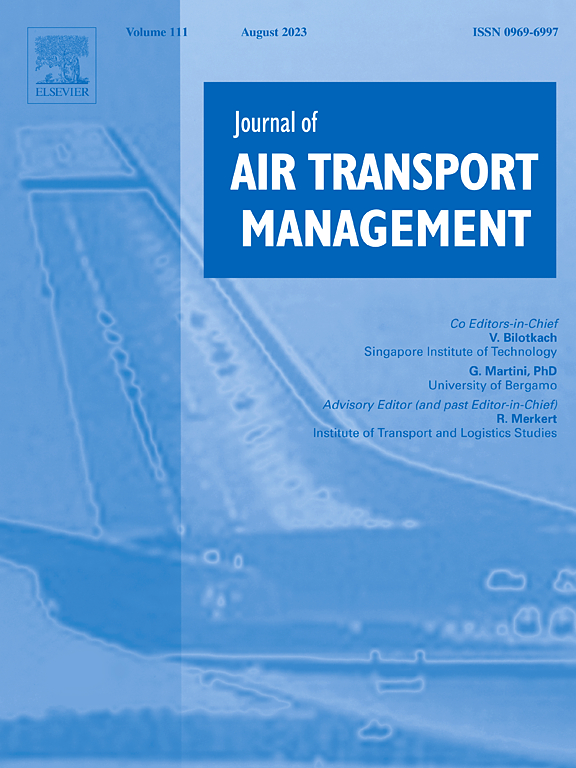带时间窗的电动拖曳车辆路径问题生命周期评估:三阶段线性充电和部分充电策略
IF 3.6
2区 工程技术
Q2 TRANSPORTATION
引用次数: 0
摘要
随着航空旅行需求的增加,用电动拖曳车(etv)取代燃油拖曳车(ftv)是降低机场地面服务成本的一种行之有效的策略。这些ETV车队的有效部署和运营在很大程度上依赖于复杂的优化模型来管理他们的日常调度和收费。然而,以往的优化模型往往忽略了综合生命周期评估(LCA),采用了简化的收费假设,限制了其准确性和实用性。本研究通过引入创新的考虑生命周期时间窗的电动拖车路径问题(ETVRPTW-LC)模型,将生命周期成本分为固定成本、运营成本和环境成本,解决了这些差距。此外,与传统的线性或完全充电方法相比,集成三阶段线性充电和部分充电策略可以更准确地模拟ETV充电的非线性和操作现实,从而提高模型的保真度。采用自适应大邻域搜索(ALNS)算法和模拟退火(SA)算法求解局部最优性。利用南京禄口国际机场三种场景的数据进行数值实验,得出了主要结论:(1)在考虑生命周期成本时,etv比ftv实现了5% - 10%的成本优势。(2) ETV成本集中在运行前和运行后阶段,而燃料动力成本在运行阶段占主导地位。此外,敏感性分析评估了关键运行参数对生命周期成本的影响。研究结果为机场管理者提供了拖曳作业的优化策略,以提高成本效率和机场脱碳。本文章由计算机程序翻译,如有差异,请以英文原文为准。
A life cycle assessment of electric towing vehicle routing problem with time windows: Three-stage linear charging and partial charging strategy
With the increasing demand for air travel, replacing fuel-powered towing vehicles (FTVs) with electric towing vehicles (ETVs) is a proven strategy for reducing airport ground service costs. The effective deployment and operation of these ETV fleets heavily rely on sophisticated optimization models to manage their daily scheduling and charging. However, previous optimization models often overlook comprehensive life cycle assessment (LCA) and employ simplified charging assumptions, limiting their accuracy and practical applicability. This study addresses these gaps by introducing an innovative Electric Towing Vehicle Routing Problem with Time Windows considering Life Cycle (ETVRPTW-LC) model, categorizing life cycle costs into fixed, operational, and environmental costs. Furthermore, integrating a three-stage linear charging and partial charging strategy enhances model fidelity by more accurately simulating the non-linear and operational realities of ETV recharging compared to traditional linear or full-charge approaches. The Adaptive Large Neighbourhood Search (ALNS) algorithm and Simulated Annealing (SA) algorithm are applied to address local optimality. Numerical experiments, using data from Nanjing Lukou International Airport across three scenarios, demonstrate key findings: (1) ETVs achieve a 5 %–10 % cost advantage over FTVs when considering life cycle costs. (2) ETV costs are concentrated in pre-operation and post-operation phases, while fuel-powered costs dominate the operational phase. Additionally, sensitivity analysis evaluates the impact of key operational parameters on life cycle costs. The results provide airport managers with optimized strategies for towing operations for cost efficiency and airport decarbonization.
求助全文
通过发布文献求助,成功后即可免费获取论文全文。
去求助
来源期刊

Journal of Air Transport Management
TRANSPORTATION-
CiteScore
12.40
自引率
11.70%
发文量
97
期刊介绍:
The Journal of Air Transport Management (JATM) sets out to address, through high quality research articles and authoritative commentary, the major economic, management and policy issues facing the air transport industry today. It offers practitioners and academics an international and dynamic forum for analysis and discussion of these issues, linking research and practice and stimulating interaction between the two. The refereed papers in the journal cover all the major sectors of the industry (airlines, airports, air traffic management) as well as related areas such as tourism management and logistics. Papers are blind reviewed, normally by two referees, chosen for their specialist knowledge. The journal provides independent, original and rigorous analysis in the areas of: • Policy, regulation and law • Strategy • Operations • Marketing • Economics and finance • Sustainability
 求助内容:
求助内容: 应助结果提醒方式:
应助结果提醒方式:


